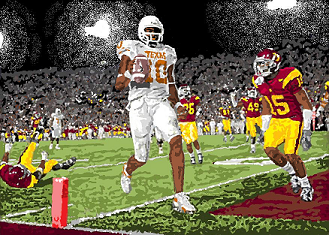1)
Texas 13-0
2) Southern Cal 12-1
3) Penn State 11-1
4) Ohio State 10-2
5) West Virginia 11-1
6) Louisiana State 11-2
7) Virginia Tech 11-2
8) Alabama 10-2
9) Notre Dame 9-3
10) Georgia 10-3
11) Texas Christian 11-1
12)
Florida 9-3
13) Oregon 10-2
14) Auburn 9-3
15) Wisconsin 10-3
16) UCLA 10-2
17) Miami (FL) 9-3
18) Boston College 9-3
19) Louisville 9-3
20) Texas Tech 9-3
21) Clemson 8-4
22) Oklahoma 8-4
23) Florida State 8-5
24) Nebraska 8-4
25) California 8-4
The first thing I notice here is SEC champion Georgia (10-3) being ranked four slots behind 11-2 Louisiana State, whom Georgia defeated resoundingly in the SEC title game, 34-14. Has an injustice been dealt to the Bulldogs?
I myself would rank Georgia ahead of LSU, as their head-to-head win was very decisive, came at the end of the season when the stakes were at their highest, and Georgia's bowl loss was by 3 points to a team ranked higher than LSU (West Virginia).
However, AP poll voters do have a case for rating LSU higher this year...

My painting of the 2005 season's play of the year: Vince Young scoring the winning touchdown from 9 yards out on 4th and 5 with 19 seconds left. Thus ended Southern Cal's pursuit of a "threepeat," as well as talk of USC 2005 being the greatest team of all time.
